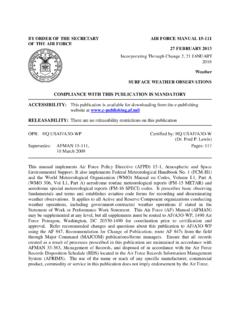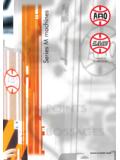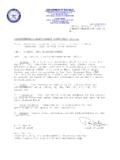Transcription of DEPARTMENT OF LICENSING AND REGULATORY …
1 1 MIOSHA-STD-1403 (10/15) 32 Pages For further information Ph: 517-284-7740 DEPARTMENT OF LICENSING AND REGULATORY AFFAIRS DIRECTOR'S OFFICE OCCUPATIONAL HEALTH STANDARDS Filed with the Secretary of State on October 18, 1993 (as amended October 18, 1999) (as amended February 6, 2014) These rules become effective immediately upon filing with the Secretary of State unless adopted under section 33, 44, or 45a(6) of 1969 PA 306. Rules adopted under these sections become effective 7 days after filing with the Secretary of State. (By authority conferred on the director of the DEPARTMENT of LICENSING and REGULATORY affairs by sections 14 and 24 of 1974 PA 154, MCL and ; and Executive Reorganization Order Nos. 1996-1, 1996-2, 2003-1, 2008-4, and 2011-4, MCL , , , , and ) R and R of the michigan Administrative Code are amended, and R is added, as follows: PART 603. LEAD EXPOSURE IN CONSTRUCTION Table of Contents: R Scope and application.
2 1 R Adoption by reference of federal regulations.. 1 R Obtaining adopted and referenced standards.. 2 Lead .. 2 Appendix A Substance Data Sheet for Occupational Exposure to Lead .. 15 Appendix B Employee Standard Summary .. 17 Appendix C Medical Surveillance Guidelines .. 24 R Scope and application. Rule 1. These rules apply to all construction work as defined by the michigan Occupational Safety and Health Act (MIOSHA), 1974 PA 154, MCL to Construction work includes all of the following: (a) Demolition or salvage of structures where lead or materials containing lead are present. (b) Removal or encapsulation of materials containing lead. (c) New construction, alteration, repair, painting, decorating, or renovation of structures, substrates, or portions thereof that contain lead or materials containing lead. (d) Installation of products containing lead. (e) Lead contamination or emergency cleanup.
3 (f) Transportation, disposal, storage, or containment of lead or materials containing lead on the site or location at which construction activities are performed. (g) Maintenance operations associated with the construction activities described in this rule. R Adoption by reference of federal regulations. Rule 2. (1) The federal occupational safety and health administration s regulations on lead exposure in construction promulgated by the United States DEPARTMENT of labor and codified at 29 , Lead Exposure in Construction, as amended on March 26, 2012, are adopted in these rules. (2) The federal regulations adopted in subrule (1) of this rule have the same force and effect as a rule promulgated pursuant to the provisions of the michigan Occupational Safety and Health Act (MIOSHA), 1974 PA 154, MCL to (3) All of the following provisions apply as used in these rules.
4 (a) A reference to 29 , Hazard communication, in 29 (d) means Occupational Health Standard Part 430 Hazard Communication, and Construction Safety Standard Part 42 Hazard Communication, as referenced in R 2 (b) A reference to 29 , Eye and face protection, in 29 (g) means Occupational Health Standard Part 433 Personal Protective Equipment, General Industry Safety Standard Part 33 Personal Protective Equipment, and Construction Safety Standard Part 6 Personal Protective Equipment, as referenced in R (c) A reference to 29 , Access to employee exposure and medical records, in 29 (l) means Occupational Health Standard Part 470 Employee Medical Records and Trade Secrets, as referenced in R R Obtaining adopted and referenced standards. Rule 3. (1) The OSHA regulations adopted in R are available from the United States DEPARTMENT of Labor, Occupational Safety and Health Administration, via the internet at website , at no charge as of the time of adoption of these rules.
5 (2) The standards adopted in R are also available for inspection at the DEPARTMENT of LICENSING and REGULATORY Affairs, MIOSHA Standards Section, 7150 Harris Drive, Box 30643, Lansing, michigan , 48909-8143. (3) Copies of the standards adopted in R may be obtained from the publisher or may also be obtained from the DEPARTMENT of LICENSING and REGULATORY Affairs, MIOSHA Standards Section, 7150 Harris Drive, Box 30643, Lansing, michigan , 48909-8143, plus $ for shipping and handling. (4) The following michigan occupational safety and health standards are referenced in R and R Up to 5 copies of these standards may be obtained at no charge from the michigan DEPARTMENT of LICENSING and REGULATORY affairs, MIOSHA standards section, 7150 Harris Drive, Box 30643, Lansing, MI, 48909-8143 or via the internet at website: For quantities greater than 5, the cost, at the time of adoption of these rules, is 4 cents per page.
6 (a) Construction Safety Standard Part 6 Personal Protective Equipment, R to R (b) Construction Safety Standard Part 42 Hazard Communication, R to R (c) General Industry Safety Standard Part 33 Personal Protective Equipment, R to R (d) Occupational Health Standard Part 430 Hazard Communication, R to R (e) Occupational Health Standard Part 433 Personal Protective Equipment, R to R (f) Occupational Health Standard Part 470 Employee Medical Records and Trade Secrets, R to R LEAD Table of Contents: Lead .. 2 (a) Scope.. 3 (b) 3 (c) Permissible exposure limit.. 3 (d) Exposure assessment.. 3 (e) Methods of compliance.. 6 (f) Respiratory protection.. 7 (g) Protective work clothing and equipment. 7 (h) Housekeeping.. 8 (i) Hygiene facilities and practices.. 8 (j) Medical surveillance.. 9 (k) Medical removal protection.
7 11 (l) Communication of hazards.. 12 (m) Signs.. 13 (n) Recordkeeping .. 14 (o) Observation of monitoring.. 15 (p) 15 Appendix A Substance Data Sheet for Occupational Exposure to Lead .. 15 I. Substance 15 II. Health Hazard Data .. 15 Appendix B Employee Standard Summary .. 17 I. Permissible Exposure Limit (PEL).. 17 II. Exposure Assessment .. 17 III. Methods of Compliance .. 18 IV. Respiratory Protection .. 18 V. Protective Work Clothing and Equipment .. 19 VI. Housekeeping .. 20 VII. Hygiene Facilities and Practices .. 20 VIII. Medical surveillance .. 20 IX. Medical Removal Protection .. 22 X. Employee Information and Training .. 23 XI. Signs .. 23 XII. Recordkeeping .. 23 XIII. Observation of Monitoring .. 24 XIV. For Additional Information .. 24 Appendix C Medical Surveillance Guidelines .. 24 Introduction .. 24 I. Medical Surveillance and Monitoring Requirements for Workers Exposed to Inorganic Lead .. 25 II. Adverse Health Effects of Inorganic Lead.
8 27 III. Medical Evaluation.. 29 IV. Laboratory Evaluation.. 30 Summary.. 32 3 (a) Scope. This section applies to all construction work where an employee may be occupationally exposed to lead. All construction work excluded from coverage in the general industry standard for lead by 29 CFR (a)(2) is covered by this standard. Construction work is defined as work for construction, alteration and/or repair, including painting and decorating. It includes but is not limited to the following: (a)(1) Demolition or salvage of structures where lead or materials containing lead are present; (a)(2) Removal or encapsulation of materials containing lead; (a)(3) New construction, alteration, repair, or renovation of structures, substrates, or portions thereof, that contain lead, or materials containing lead; (a)(4) Installation of products containing lead; (a)(5) Lead contamination/emergency cleanup; (a)(6) Transportation, disposal, storage, or containment of lead or materials containing lead on the site or location at which construction activities are performed, and (a)(7) Maintenance operations associated with the construction activities described in this paragraph.
9 (b) Definitions. Action level means employee exposure, without regard to the use of respirators, to an airborne concentration of lead of 30 micrograms per cubic meter of air (30 ug/m3) calculated as an 8-hour time-weighted average (TWA). Assistant Secretary means the Assistant Secretary of Labor for Occupational Safety and Health, DEPARTMENT of Labor, or designee. Competent person means one who is capable of identifying existing and predictable lead hazards in the surroundings or working conditions and who has authorization to take prompt corrective measures to eliminate them. Director means the Director, National Institute for Occupational Safety and Health (NIOSH), DEPARTMENT of Health and Human Services, or designee. Lead means metallic lead, all inorganic lead compounds, and organic lead soaps. Excluded from this definition are all other organic lead compounds. This section means this standard.
10 (c) Permissible exposure limit. (c)(1) The employer shall assure that no employee is exposed to lead at concentrations greater than fifty micrograms per cubic meter of air (50 ug/m3) averaged over an 8-hour period. (c)(2) If an employee is exposed to lead for more than 8 hours in any work day the employees' allowable exposure, as a time weighted average (TWA) for that day, shall be reduced according to the following formula: Allowable employee exposure (in ug/m3) = 400 divided by hours worked in the day. (c)(3) When respirators are used to limit employee exposure as required under paragraph (c) of this section and all the requirements of paragraphs (e)(1) and (f) of this section have been met, employee exposure may be considered to be at the level provided by the protection factor of the respirator for those periods the respirator is worn.













